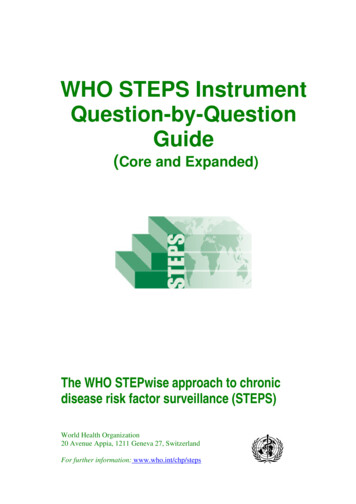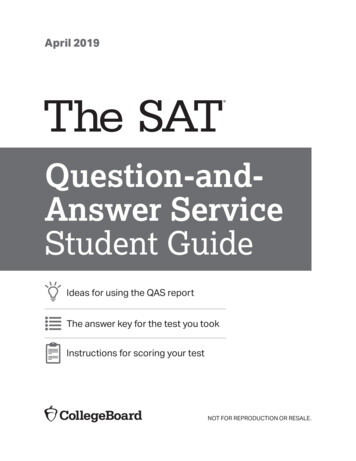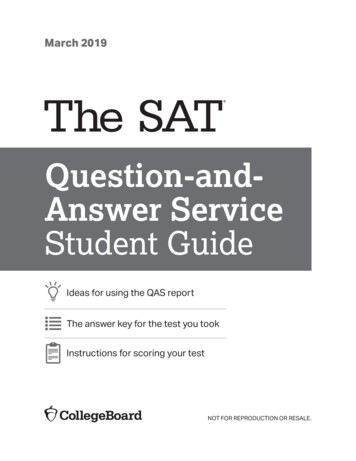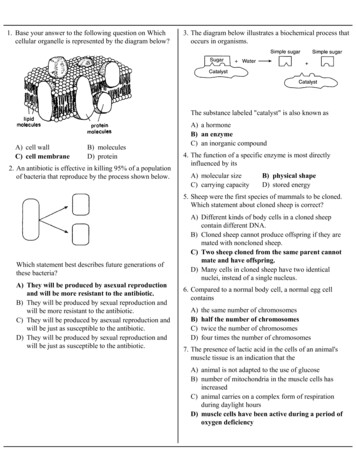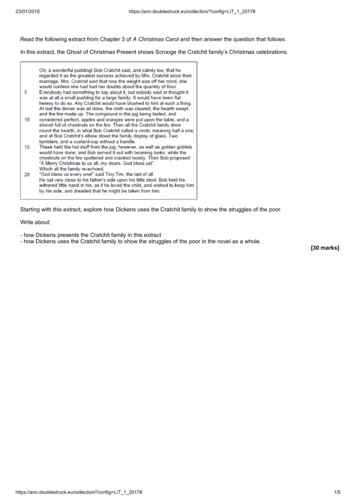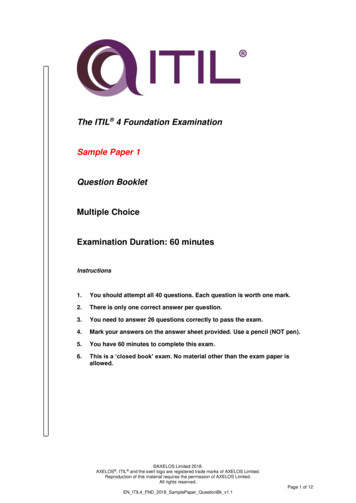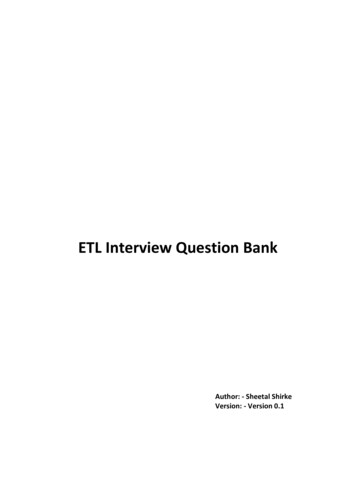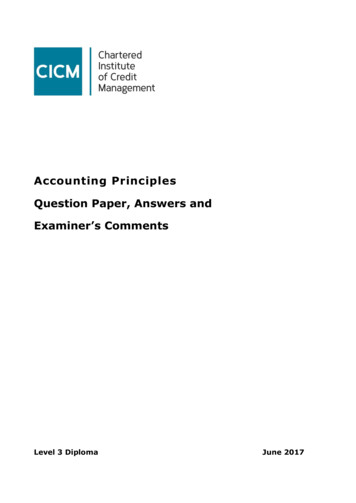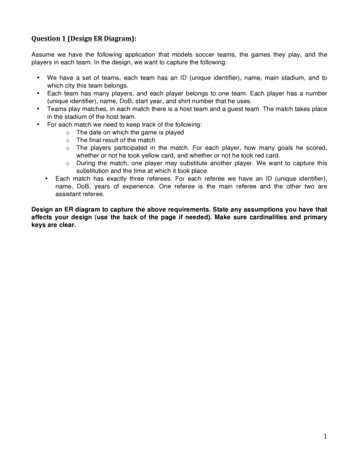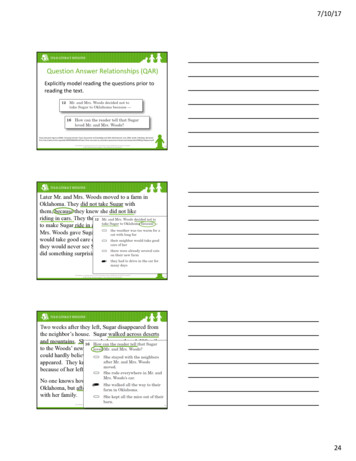
Transcription
7/10/17Question Answer Relationships (QAR)Explicitly model reading the questions prior toreading the text.Texas Education Agency (2006). Amazing Animals! Texas Assessment of Knowledge and Skills Administered, June 2006, Grade 3 Reading. Retrievedfrom /release/taks/2006/gr3taksjune.pdfThe Children’s Learning Institute at The University of Texas Health Science Center at Houston 2015 Texas Education Agency / The University of Texas System70Later Mr. and Mrs. Woods moved to a farm inOklahoma. They did not take Sugar withthem, because they knew she did not likeriding in cars. They thought it would be cruelto make Sugar ride in a car for days. Mr. andMrs. Woods gave Sugar to a neighbor whowould take good care of her. They thoughtthey would never see Sugar again. But the catdid something surprising.The Children’s Learning Institute at The University of Texas Health Science Center at Houston 2015 Texas Education Agency / The University of Texas System71Two weeks after they left, Sugar disappeared from the neighbor’s house. Sugar walked across desertsand mountains. She traveled more than 1,500 milesto the Woods’ new farm! Mr. and Mrs. Woodscould hardly believe their eyes when Sugarappeared. They knew that the cat was Sugarbecause of her left hip.No one knows how Sugar found her way toOklahoma, but after 14 months Sugar was homewith her family.Released TAKS Test: June 2006 Grade 3 RetestThe Children’s Learning Institute at The University of Texas Health Science Center at Houston 2015 Texas Education Agency / The University of Texas System7224
7/10/17Explicitly Teaching Test-Taking Skills13The Children’s Learning Institute at The University of Texas Health Science Center at Houston 2015 Texas Education Agency / The University of Texas System73Your Turn (Step 5)14The Children’s Learning Institute at The University of Texas Health Science Center at Houston 2015 Texas Education Agency / The University of Texas System74Your Turn (Step 5) Choose one of the questionsto work with. Practice a QAR think-aloud forthe question you haveselected. Refer to the TestTaking Tips and QAR handouts. To ensure that your lesson isclear and explicit, plan whatyou will say to students.14The Children’s Learning Institute at The University of Texas Health Science Center at Houston 2015 Texas Education Agency / The University of Texas System7525
7/10/17The Children’s Learning Institute at The University of Texas Health Science Center at Houston 2015 Texas Education Agency / The University of Texas SystemReferencesAfflerbach, P. (2007). Understanding and using reading assessment, K-12. International ReadingAssociation.Beck, I. & McKeown, M. (2001). Text talk: Capturing the benefits of read-aloud experiences foryoung children. The Reading Teacher, 55 (1), 10-20.Block, C., Parris, S., & Whiteley, C. (2008). CPMs: A kinesthetic comprehension strategy. TheReading Teacher, 61 (6), 460-470.Center for the Improvement of Early Reading Achievement (CIERA). (2003). Put reading first: Theresearch building blocks for teaching children to read. National Institute for Literacy.Conrad, L., Matthews, M., Zimmerman, C., & Allen, P. (2008). Put thinking to the test. Portsmouth,NH: Heinemann.Commeyras, M. (1995). What can we learn from students’ questions? Theory into Practice, 34(2),101-106.Commeyras, M. & Sumner, G. (1998). Literature questions children want to discuss: Whatteachers and students learned in a second-grade classroom. The Elementary School Journal,99 (2), 129-152.Coyne, M., Chard, D., Zipoli, R., & Ruby, M. (2007). Effective strategies for teachingcomprehension. In M. Coyne, E. Kame’enui, & D. Carnine (Eds.), Effective teaching strategiesthat accommodate diverse learners. Upper Saddle River, NJ: Pearson Education, Inc.The Children’s Learning Institute at The University of Texas Health Science Center at Houston 2015 Texas Education Agency / The University of Texas System77ReferencesDaniels, H., & Zemelman, S. (2004). Subjects matter: Every teacher's guide to content-areareading. Portsmouth, NH: Heinemann.Duke, N.K. & Pearson, P.D., (2002). Effective practices for developing reading comprehension. InA. E. Farstrup & S.J. Samuels (Eds.), What research has to say about reading instruction.Newark, DE: International Reading Association, Inc.Duffy, G., Roehler, L., Sivan, E., Rackliffe, G., Book, C., & Meloth, M. (1987). Effects of explainingthe reasoning associated with using reading strategies. Reading Research Quarterly, 22 (3),347-368.Durkin, D. (1978-1979). What classroom observations reveal about reading comprehensioninstruction. Reading Research Quarterly, 14 (4), 481-533.Gersten, R., Fuchs, L., Williams, J., & Baker, S. (2001). Teaching Reading Comprehension Strategiesto Students With Learning Disabilities: A Review of Research. Review of EducationalResearch, 279-320.Goodman Le, K., & DeFilippo, C. (2008). Little philosophers: Socratic seminars can help even theyoungest learners think critically and creatively. Educational Leadership, 66 (2), 66-69.The Children’s Learning Institute at The University of Texas Health Science Center at Houston 2015 Texas Education Agency / The University of Texas System7826
7/10/17ReferencesGreene, A. & Doyle Melton, G. (2007). Test talk: Integrating test preparation into readingworkshop. Portland ME: Stenhouse.Hoyt, l. (2007). Interactive read-alouds: Linking standards, fluency, and comprehension.Portsmouth NH: Heinemann.Israel, S. E., & Duffy, G. G. (Eds.). (2009). Handbook of research on reading comprehension. NewYork: Routledge.Keene, E., & Zimmermann, S. (2007). Mosaic of thought: The power of comprehension strategyinstruction (2nd Ed.). Portsmouth, NH: Heinemann.Klingner, J., Vaughn, S., & Boardman, A. (2007). Teaching reading comprehension to students withlearning difficulties. New York, NY: The Guilford Press.Mantione, R. & Smead, S. (2003). Weaving through words: Using the arts to teach readingcomprehension strategies. International Reading Association.McClure, L. (2012). A Chance for Freedom. Retrieved August 28, 2015 assages/840 a chance for freedom 0.pdfMiller, D. (2002). Reading with meaning: Teaching comprehension in the primary grades.Portland, ME: Stenhouse Publishers.The Children’s Learning Institute at The University of Texas Health Science Center at Houston 2015 Texas Education Agency / The University of Texas System79ReferencesNational Reading Panel. (2000). Report of the National Reading Panel: Teaching children to read.Report of the subgroups. Washington, D.C.: U.S. Department of Health and Human Services,National Institutes of Health.Neil Postman. (n.d.). Retrieved August 28, 2015. fromhttps://en.wikiquote.org/wiki/Neil PostmanNikola Tesla (1900). Picture source retrieved on March 12, 2009 from:http://commons.wikimedia.org/wiki/File:Tesla colorado.jpgParker, M., & Hurry, J. (2007). Teachers’ use of questioning and modeling comprehension skills inprimary classrooms. Educational Review, 59 (3), 299-314.Pearson, P.D., Roehler, L., Dole, J., & Duffy, G. (1992). Developing expertise in readingcomprehension. In A.E. Farstrup & S.J. Samuels (Eds.), What research has to say aboutreading instruction. Newark, DE: International Reading Association, Inc.Pressley, M. (2000). What should comprehension instruction be the instruction of? In M. Kamil, P.Mosenthal, P. D. Pearson & R. Barr (Eds.), Handbook of reading research (Vol. III, pp. 545–561). Mahwah, NJ: Lawrence Erlbaum.The Children’s Learning Institute at The University of Texas Health Science Center at Houston 2015 Texas Education Agency / The University of Texas System80ReferencesRAND Reading Study Group. (2002). Reading for understanding: Toward an R&D program inreading comprehension. Santa Monica, CA: RAND, Office of Educational Research andImprovement, U.S. Department of Education.Raphael, T. & Au, K. (2005). QAR: Enhancing comprehension and test taking across grades andcontent areas. The Reading Teacher, 59 (3), 206-221.Released Grade 3 TAKS tests retrieved on March 12, 2009 nshine, B., Meister, C., & Chapman, S. (1996). Teaching students to generate questions: Areview of the intervention studies. Review of Educational Research, 6 (2), 181-221.Routman, R. (2003). Reading Essentials. Portsmouth, NH: Heinemann.Stahl, S. (2004). Effective reading instruction in first grade. Retrieved on February 12, 2009 rrc/02mrrcss.pdfSurat, M. (2000). Angel Child, Dragon Child. In SRA, Open Court Reading (Grade 3, Unit 1, p. 28).Columbus: McGraw-Hill.The Children’s Learning Institute at The University of Texas Health Science Center at Houston 2015 Texas Education Agency / The University of Texas System8127
7/10/17ReferencesTest-Taking Strategies for Three Subject Areas (n.d.) Scholastic Teachers. Retrieved September 3, 2015from king-strategies-three-subject-areasTexas Education Agency (2006). Amazing Animals! Texas Assessment of Knowledge and SkillsAdministered, June 2006, Grade 3 Reading. Retrieved rces/release/taks/2006/gr3taksjune.pdfTexas Education Agency (2014). The Dog and the Joey. State of Texas Assessments of AcademicReadiness (STAAR) Released Test Questions. Reading, Grade 3, Administered April 2014. Retrievedfromhttp://tea.texas.gov/Student Testing and Accountability/Testing/State of Texas Assessments ofAcademic Readiness (STAAR)/STAAR Released Test Questions/Time for Kids. (2001). The koala catchers. In McGraw-Hill Reading (Grade 3, Book 2, Unit 3). Columbus:McGraw-Hill.Time for Kids (2005). El rescate de koalas. In Macmillian/McGraw-Hill Lectura. (Grade 3, Book 2, Unit 3).Macmillian/McGraw-Hill.University of Texas System/Texas Education Agency. (2009). ELAR/SLAR TEKS handbook. Austin, TX: TexasEducation Agency.Walker, K. (2010). Test-Taking Strategies Research Brief. Principals’ Partnership. Retrieved September 3,2015 from e, J. (1998). Theory of mind goes to school. Educational Leadership, 56 (3), pp. 46-48.Wolf, M., & Barzilliai, M. (2009). The importance of deep reading. Educational Leadership, 66 (6), 32-37.The Children’s Learning Institute at The University of Texas Health Science Center at Houston 2015 Texas Education Agency / The University of Texas System8228
Released TAKS Test: June 2006 Grade 3 Retest 72. 7/10/17 25 The Children’s Learning Institute at The University of Texas Health Science Center at Houston . Readiness (STAAR) Released Test Questions.
